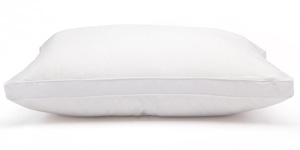Posted by Stefan Hunter on May 16, 2016
Pillow Bells & Whistles
 Pillows come in all shapes and sizes and can be a confusing item to purchase with additional features added. Many consumers are not sure how the pillow extras translate for needs and preferences. The additional pillow elements include: gussets, embroidery, piping or cording, removable protectors and more.
Pillows come in all shapes and sizes and can be a confusing item to purchase with additional features added. Many consumers are not sure how the pillow extras translate for needs and preferences. The additional pillow elements include: gussets, embroidery, piping or cording, removable protectors and more.
When a pillow is designed, the basic construction includes a rectangle shape filled with various fillings. Different fillings will determine whether products are sold as down pillows, down alternative pillows or polyester pillows. Pillows in the United States come in six basic sizes, yet the majority of your local stores only sell standard, queen and king.
The six basic sizes are:
- Standard – 20x26
- Jumbo – 20x28
- Queen – 20x30
- King – 20x36
- Euro – 26x26
- Body – 20x54 or 20x60
Why Are Some Pillows Thicker?

Pillows that have ‘gussets’, also called ‘sidewalls’, are basically a pillow that features a border or panel in the middle of the outside. This additional middle fabric allows the pillow to be thicker to contain more filling. Typically, the pillow gusset runs ½ an inch to 2 inches wide. Department stores like pillows that look thicker because consumers view the additional filling as visually more interesting. We do know that the greater the internal volume, the more filling is needed to keep the ‘full’ look. This additional filling is appealing for someone who wants a firmer pillow (this assumes the pillow fill weight is increased to allow for that correct density).
Having a gusset does not make a pillow firmer. In fact, a gusset application means the pillow can run soft, medium, or firm, having the same application as in the standard pillow construction. In most cases, a pillow with a gusset application can be used in standard pillowcases. Sometimes a store may run a promotional pillow with a really wide gusset, such as 3 inches. Wide gussets can make it difficult to fit a pillow into a pillowcase making an unattractive ‘couch cushion’ look.
What Are The Different Trims or Embellishments on a Pillow?

Some pillows feature piping or braiding as a decorative aesthetic enhancement. Generally these decorative elements don't alter the benefits of a pillows form. In some extreme cases the piping or braiding, if large enough, could cause an uncomfortable bump underneath a pillow case, but that is a rare design occurrence. Other decorative elements may include printed fabrics or decorative stitching on the gusset or both.
Why Do Some Pillows Have A Pillow Protector?

Some pillows feature a bonus pillow protector, making caring for the pillow easier. It's coverage gives added protection from oils, stains, wear and tear and other various soil exposure, extending the life of the pillow. It is typical that a basic pillow would be a covered with protector of nicer fabric. For example, a 500 TC pillow might use a 500 TC pillow protector and a 230 cambric cotton inner pillow. At DOWNLITE we look for pillow protectors that feature a premium smooth zipper so the zipper is not felt when closed and in use.
Why Do Some Pillows Have Embroidery?

Some department stores and brands like to use an embroidered logo on their pillows, typically on the outside pillow protector. The embroidery does not serve a purpose, but is used to enforce the brand in a store setting for extra visual appeal.

